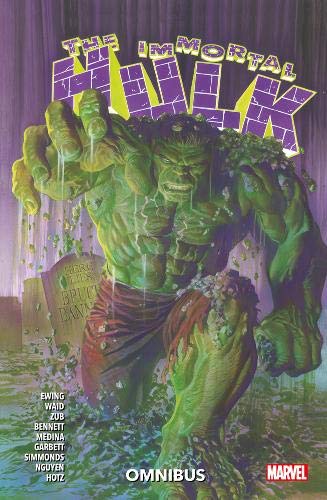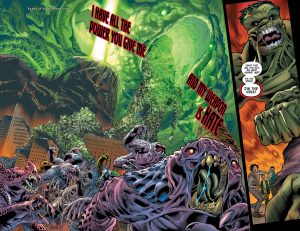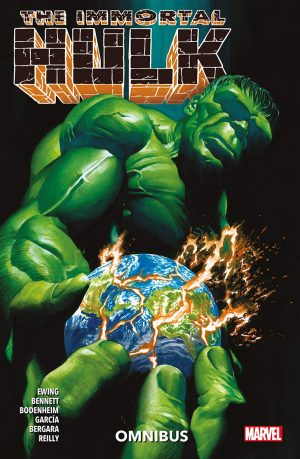Review by Frank Plowright
Under Al Ewing and Joe Bennett The Immortal Hulk is a smart, consistently surprising and ambitious take on the Hulk that also supplies the expected Hulk action. The legitimacy of expensive oversized Omnibus editions can be debated elsewhere, but if your idea is quality being the defining factor, then this is a collection to invest in, as each re-reading further reveals the depth of Ewing’s plotting. Over the entire history of the Hulk since the early 1960s only Peter David has brought as much intelligence and inspiration.
When first introduced as a primal monster who came out at night, the Hulk was the star of a horror series rather than a superhero one, and it’s an aspect Al Ewing restores, especially over an incredible opening story in which the Hulk is barely seen. However, that’s only one thread of Ewing’s approach as he takes in several other influences. There’s a nod to the late 1970s TV Hulk, in which David Banner wanders from town to town, a spiritual link to Alan Moore’s Swamp Thing via a restless redefinition of what the Hulk is capable of, and to David by constantly changing what the Hulk is. This is with a more definitive recourse to Dissociative Identity Disorder and what’s likely to have caused it, classifying the assorted Hulk personalities on view over the years from the raging monster to the level-headed scientist. Not all old favourites are seen in this opening selection, but those absent turn up in Omnibus Vol. 2.
Other than Bruce Banner seemingly having survived his fatal injury from Civil War II, there’s no immediate indication as to why the series carries the “immortal” adjective, but this is something Ewing addresses when the Hulk is captured. It results in a series-defining chapter, where what the Hulk is and what he can do is recalibrated, and it’s a modification with relevance to all gamma radiation-created identities.
Joe Bennett handles most of the artwork, providing a suitably scary Hulk (terrifying in the opening chapter), fantastic action sequences, and disciplined naturalistic art otherwise. In keeping with the horror infusion, he uses a disturbing transition process for Banner becoming the Hulk. Bennett is solid throughout, but a series characteristic is using guest artists with wildly different styles for purpose-constructed sequences. It’s both valid and a novelty, with the guests slotting in nicely other than the untidy experiment of having Bennett and Martin Simmonds drawing alternate pages of the same fight.
If you’re inclined to avoid change and innovation in superhero comics, don’t be put off by the series being acclaimed for that. Ewing remains true to the core values of the Hulk, and his interpretation includes plenty of nods to the past. The Hulk is targeted by a relentless, government-funded military organisation, old friends and enemies return, and much is made of the Hulk’s mind.
The Immortal Hulk has been an unqualified critical and commercial success, so is also available in other formats. Those wanting a hardback without springing for an Omnibus price can pick up The Immortal Hulk Volume 1 and Volume 2, while the paperback versions are titled Or is He Both?, The Green Door and Hulk in Hell.


